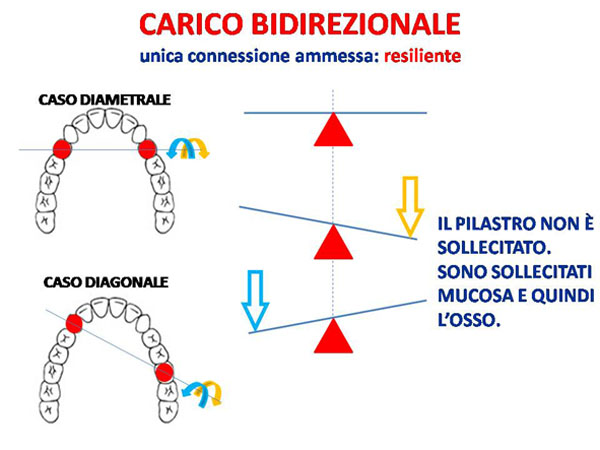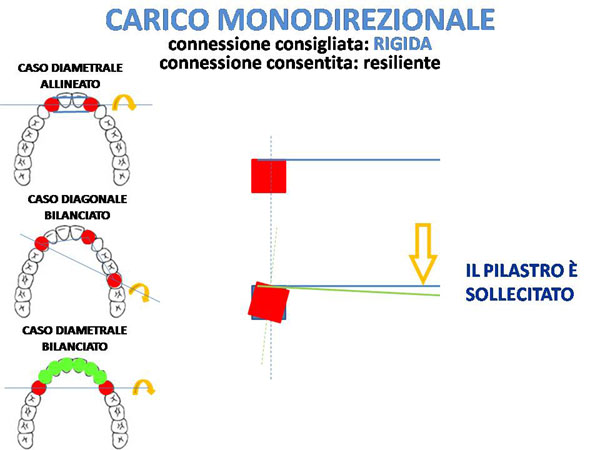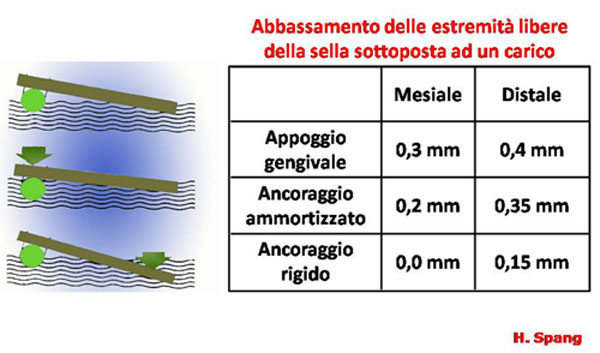Until the ‘70 people used to think that rigid connections could stress the pillar teeth more than their load capability and so they were considered dangerous; that’s why the choice was almost for resilient attachments.
In the ’70 was demonstrated that the use of resilient attachments caused a series of disadvantages such as a high reabsorption of the alveolar ridges and consequent damages to the alveolus of the pillar teeth.
On the opposite, the rigid attachments caused very little atrophy of the ridges and needed few reline operations.
In any case the attachments choice between rigid or resilient depends basically on three factors:
- the technicians and dentists personal philosophy of case design;
- the conditions of the specific oral cavity;
- the direction of occlusal load on the abutment teeth.
The actual orientation is to adopt rigid connexions, while in the past there where most of all resilient connexions.
In cases of prostheses with implants rigid connexions are preferred but, with traditional combined prosthesis, it is often difficult to decide how, when and why to choose a rigid connexion instead of a resilient one.
Considering that there could be different theories about the use of rigid or resilient connexions, is there any easily understandable "technical" reason to establish a reference criterion to choose which sysyem to adopt?
There are bio-mechanical reasons to determine the use of a rigid solution instead of a resilient one but, without analyse them, we can easily imagine a theoretic model made as the classic physic representation of lever degrees.
So imagine a fulcrum on which you have a segment (the lever): you apply the force on one extremity and the resistance on the other one.
Another possible representation of the system is the horizontal seesaw used by the children, who play pushing with their legs to go up and down alternately. The only different is that in our case mastication forces are applied on both the sides of the segment.
BI-DIRECTIONAL LOAD
the only accepted connexion is: resilient
DIAMETRICAL CASE
DIAGONAL CASE
NO SOLICITATION ON THE ABUTMENT. SOLICITATION ON MUCOSA AND BONE.
 |
When the abutment elements (natural teeth or implants) are positioned on the diametric or diagonal line of the arch, partially or fully opposed (for instance 2 premolars or 1 canine and 1 molar) resilient connexions are suggested, that means free to rotate on the axis of the lever-fulcrum constraint, so that solicitations will load above all on mucosa and then on the bone.
In case of rigid prosthetic connexion, in fact, the lever-fulcrum constraint, passed through by the rotation axis that connects the two abutments, becomes the resistance point while mastication forces which act on the prosthesis (and on the lever), become the point of effort.
During the mastication, the point of force moves continuously (according to the position of the food) and causes a very dangerous bidirectional solicitation (and the consequent movement) of the constraint, which is the abutment.
|
MONO-DIRECTIONAL LOAD
suggested connexion: RIGID
allowed connexion: resilient
 |
When the abutment elements (natural teeth or implants) are aligned along the arch and the virtual line that joins them (large like the elements) remains on the dimension of the arch, or when they are opposite but between them there are other pillars, rigid connexions are suggested.
The originated solicitations are in fact mono-directional and less dangerous because once stopped the load, on the abutment there isn’t any opposite solicitation and it goes back to its natural physiological position.
|
E’ preferibile infatti, quando la situazione lo consente, caricare gli elementi pilastro e non le parti mucose e quindi l’osso.
E’ noto infatti che le protesi ad appoggio mucoso (totali, resilienti ed ammortizzate) provocano un riassorbimento osseo da 2 a 4 più veloce delle protesi rigide.
It is better, when the situation allows it, to load the abutment elements and not the mucosa and consequently the bone.
Mucosa-supported dentures (complete dentures, resilient and amortized dentures) in fact, cause a reabsorption of the bone which is 2 or 4 times faster than that of rigid prostheses.


